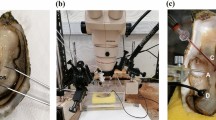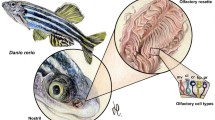Abstract
-
1.
The specificity and sensitivity of the olfactory organ of adult zebrafish, Danio rerio, to selected amino acid, bile acid, and steroid odorants were characterized using the electro-olfactogram recording technique. The olfactory organ was responsive to 28 of the 29 odorants tested.
-
2.
All of the 100 μM amino acid and bile acid stimulants elicited a negative-going response that was significantly greater than the response to the artificial freshwater control. The general pattern of relative stimulatory effectiveness established for the amino acid stimuli was neutral amino acids > basic amino acids > acidic amino acids > imino acids. The general pattern of relative stimulatory effectiveness of 100 μM bile acid stimuli was taurine-conjugated bile acids > glycineconjugated bile acids ≈ non-conjugated bile acids. The responses to the most stimulatory bile acid odorants were up to 40% larger than the responses to the most stimulatory amino acid odorants.
-
3.
The response threshold for cysteine and taurocholic acid, the most stimulatory of the amino acid and bile acid stimuli tested, was approximately 10-8 M. Females are significantly more sensitive to these odorants than males.
Similar content being viewed by others
References
Algranati, FD, Perlmutter A (1981) Attraction of zebrafish, Brachydanio rerio, to isolated and partially purified chromatographic fractions. Environ Biol Fish 6: 31–38
Baier H, Korsching S (1994) Olfactory glomeruli in the zebrafish form an invariant pattern and are identifiable across animals. J Neurosci 14: 219–230
Bjerselius R, Olsen KH (1991) Olfactory sensitivity to sexual hormones in crucian carp, Carassius carassius. In: Scott AP, Sumpter JP, Kime DE, Rolfe MS (eds): Proceedings of the 4th International Symposium on the Reproductive Physiology of Fish. University of East Anglia, Norwich, UK, 7–12 July 1991. Sheffield, U.K.: FishSymp 91, University of East Anglia Printing Unit
Bloom HD, Perlmutter A (1977) A sexual aggregating pheromone system in the zebrafish, Brachydanio rerio (Hamilton-Buchanan). J Exp Zool 199: 215–226
Buck L, Axel R (1991) A novel multigene family may encode odorant receptors: a molecular basis for odor recognition. Cell 65: 175–187
Byrd CA, Vogt RG, Brunjes PC (1994) Expression of odorant receptor proteins during post-embryonic development in zebrafish. Chem Senses 19: 448–449 (Abstract)
Caprio, J. (1978) Olfaction and taste in the channel catfish: an electrophysiological study of the responses to amino acids and derivatives. J Comp Physiol A 123: 357–371
Caprio J (1980) Similarity of olfactory receptor responses (EOG) of freshwater and marine catfish to amino acids. Can J Zool 58: 1778–1784
Cardwell JR, Dulka JG, Stacey NE (1992) Acute olfactory sensitivity to prostaglandins but not to gonadal steroids in two sympatric species of Catostomus (Pisces: Cypriniformes). Can J Zool 70: 1897–1903
Doty RL (1986) Gender and endocrine-related influences upon olfactory sensitivity. In: Meiselman ML, Rivlin RS (eds) Clinical measurement of taste and smell. MacMillan; New York, pp377–413
Doving KB, Selset R, Thommesen G (1980) Olfactory sensitivity to bile acids in salmonid fishes. Acta Physiol Scand 108: 123–131
Erickson JR, Caprio J (1984) The spatial distribution of ciliated and microvillous olfactory receptor neurons in the channel catfish is not matched by a differential specificity to amino acid and bile salt stimuli. Chem Senses 9: 127–141
Getchell TV (1974) Electrogenic sources of slow voltage transients recorded from frog olfactory epithelium. J Neurophysiol 37: 1115–1130
Goh Y, Tamura T, Kobayashi H (1979) Olfactory responses to amino acids in marine teleosts. Comp Biochem Physiol A 62: 863–868
Goh Y, Tamura T (1978) The electrical responses of the olfactory tract to amino acids in carp. Bull Jpn Soc Sci Fish 44: 341–344
Hansen A, Zeiske E (1993) Development of the olfactory organ in the zebrafish, Brachydanio rerio. J Comp Neurol 333: 289–300
Hara TJ, Law YMC, Hobden BR (1973) Comparison of the olfactory response to amino acids in rainbow trout, brook trout, and whitefish. Comp Biochem Physiol A 45: 969–977
Hara TJ (1976) Structure activity relationships of amino acids in fish olfaction. Comp Biochem Physiol A 54: 31–36
Hara TJ (1977a) Amino acids as olfactory stimuli in fish. In: Le Magnen J, MacLeod P (eds) Olfaction and Taste VI. Paris: Information Retrieval, pp 157–164
Hara TJ (1977b) Further studies on the structure-activity relationships of amino acids in fish olfaction. Comp Biochem Physiol A 56: 559–565
Hara TJ, Macdonald S, Evans RE, Marui T, Arai S (1984) Morpholine, bile acids and skin mucus as possible chemical cues in salmonid homing: electrophysiological reevaluation. In: McCleave JD, Arnold GP, Dodson JD, Neill WH (eds) Mechanisms of Migration in Fishes. New York: Plenum Publishing Corporation, pp. 363–378
Hara TJ (1992) Fish chemoreception. Amsterdam: Elsevier
Holley A (1991) Neural coding of olfactory information. In: Getchell TV, Doty RL, Bartoshuk LM, Snow JB Jr (eds) Smell and taste in health and disease. New York: Raven Press, pp329–343
Irvine IAS, Sorensen PW (1993) Acute olfactory sensitivity of wild common carp, Cyprinus carpio, to goldfish hormonal sex pheromones is influenced by gonadal maturity. Can J Zool 71: 2199–2210
Johnsen PB, Adams MA (1986) Chemical feeding stimulants for the herbivorous fish, Tilapia zillii. Comp Biochem Physiol A 83: 109–112
Kimmel CB (1993) Patterning the brain of the zebrafish embryo Annu Rev Neurosci 16: 707–732
Korsching S, Baier H (1992) Towards a coding strategy in the fish olfactory system. Chem Senses 17: 653 (Abstract)
Li W, Sorensen PW (1994) High specificity of the sea lamprey olfactory system to four classes of bile acids. Chem Senses 19: 506 (Abstract)
Meyer A, Biermann CH, Ortí G (1993) The phylogenetic position of the zebrafish (Danio rerio), a model system in developmental biology: an invitation to the comparative method. Proc R SocLond [Biol] 252: 231–236
Moore A, Scott AP (1992) 17α,20β-dihydroxy-4-pregnen-3-one 20sulphate is a potent odorant in precocious male Atlantic salmon (Salmo salar L.) parr which have been pre-exposed to the urine of ovulated females. Proc R Acad Lond B 249: 205–209
Ngai J, Dowling MM, Buck L, Axel R, Chess A (1993) The family of genes encoding odorant receptors in the channel catfish. Cell 72: 657–666
Okano M, Takagi SF (1974) Secretion and electrogenesis of the supporting cell in the olfactory epithelium. J Physiol 242: 353–370
Raming K, Krieger J, Strotman J, Boekhoff I, Kubick S, Baumstark C, Breer H (1993) Cloning and expression of odorants receptors. Nature 361: 353–356
Rossant J, Hopkins N (1992) Of fin and fur: mutational analysis of vertebrate embryonic development. Genes and Development 6: 1–13
Selman K, Wallace RA, Sarka A, Qi X (1993) Stages of oocyte development in the zebrafish, Brachydanio rerio. J Morphol 218: 203–224
Selman K, Petrino TR, Wallace RA (1994) Experimental conditions for oocyte maturation in the zebrafish, Brachydanio rerio. J Exp Zool 269: 538–550
Silver WL, Caprio J, Blackwell JF, Tucker D (1976) The underwater electro-olfactogram: a tool for the study of the sense of smell of marine fishes. Experientia 32: 1216–1217
Sorensen PW, Hara TJ, Stacey NE (1987) Extreme olfactory sensitivity of mature and gonadally-regressed goldfish to a potent steroidal pheromone, 17α,20β-dihydroxy-4-pregnen-3-one. J Comp Physiol A 160: 305–313
Sorensen PW, Hara TJ, Stacey NE, Goetz FW (1988) F prostaglandins function as potent olfactory stimulants that comprise the postovulatory female sex pheromone in goldfish. Biol Reprod 39: 1039–1050
Sorensen PW, Goetz FW (1993) Pheromonal and reproductive function of F prostaglandins and their metabolites in teleost fish. J Lipid Mediat 6: 385–393
Spath M, Schweickert W (1977) The effect of metacaine (MS-222) on the activity of the efferent and afferent nerves in the teleost lateral-line system. Naunyn-Schmiedeberg's Arch Pharmacol 297: 9–16
Steele CW, Owens DW, Scarfe AD (1990) Attraction of zebrafish Brachydanio-rerio to alanine and its suppression by copper. J Fish Biol 36: 341–352
Steele CW, Scarfe AD, Owens DW (1991) Effects of group size on the responsiveness of zebrafish Brachydanio-rerio Hamilton Buchanan to alanine a chemical attractant. J Fish Biol 38: 553–564
Strähle U, Blader P (1994) Early neurogenesis in the zebrafish embryo. FASEB J 8: 692–698
Thommesen G (1983) Morphology, distribution, and specificity of olfactory receptor cells in salmonid fishes. Acta Physiol Scand 117: 241–250
Van Den Hurk R, Schoonen WGEJ, van Zoelen GA, Lambert JGD (1987) The biosynthesis of steroid glucuronides in the testis of the zebrafish Brachydanio rerio, and their pheromonal function as ovulation inducers. Gen Comp Endocrinol 68: 179–188
Van Den Hurk R, Lambert JGD (1983) Ovarian steroid glucuronides function as sex pheromones for male zebrafish, Brachydanio rerio. Can J Zool 61: 2381–2387
Weissburg M, Govind CK, Pearce J, Derby C (1993) Neural mechanisms regulating gender-specific patterns of behavioral chemosensitivity during foraging. Chem Senses 18: 648 (Abstract)
Weissburg M, Derby C (1994) Regulation of gender-specific chemosensory behaviors in fiddler crabs: electrophysiological properties of male and female chemoreceptor neurons. Chem Senses 19: 572 (Abstract)
Zar JH (1984) Biostatistical analysis. Englewood Cliffs: PrenticeHall
Zhang C, Hara TJ (1994) Multiplicity of salmonid olfactory receptors for bile acids as evidenced by cross-adaption and ligand binding assay. Chem Senses 19: 579 (Abstract)
Zippel HP, Lago-Schaaf T, Caprio J (1993) Ciliated olfactory receptor neurons in goldfish (Carassius auratus) partially survive nerve axotomy, rapidly regenerate and respond to amino acids. J Comp Physiol A 173: 537–547
Author information
Authors and Affiliations
Rights and permissions
About this article
Cite this article
Michel, W.C., Lubomudrov, L.M. Specificity and sensitivity of the olfactory organ of the zebrafish, Danio rerio . J Comp Physiol A 177, 191–199 (1995). https://doi.org/10.1007/BF00225098
Accepted:
Issue Date:
DOI: https://doi.org/10.1007/BF00225098




